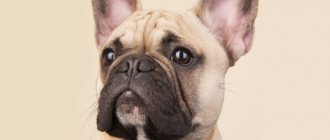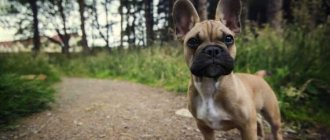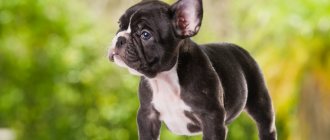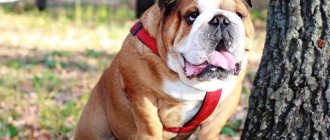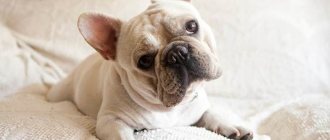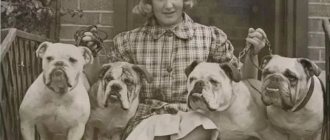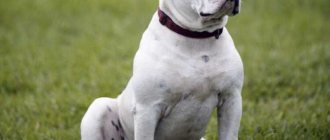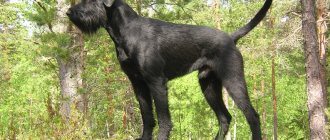| Origin | USA |
| Usage | Old English Bulldogs – helpers in herding, guards |
| Color | Different colors are allowed. Two-color: the main background is white or gray, with large spots of red, or black, or brown. Tricolor: the main background is white or gray, with spots of red, brown, and splashes of black or reddish tint |
| Dimensions | Height at withers 43-48 cm, weight 27-31 kg |
| Lifespan | 10-12 years |
When it comes to the Old English Bulldogge, the imagination pictures a sullen dog with a fierce appearance and a heavy, sullen look. Is it so? Does the appearance correspond to the character, or is there actually a vulnerable soul hiding under the intimidating appearance? By becoming familiar with the history of origin and the main character traits of the representatives of the Old English Bulldog breed, you can get a more complete and correct idea of these four-legged pets.
History of the origin of the English Bulldog
No one knows the date of origin of the Old English Bulldog. Popularity in the 18th-19th centuries. The breed gained popularity thanks to popular entertainment – bull baiting. Over time, due to its ferocity, ruthlessness and strong jaw, the breed began to be exhibited in dog fights: in a matter of minutes, powerful bulldogs could tear apart an opponent.
Old English Bulldog
In the middle of the 19th century. Dog fighting was banned and Old English bulldogs were no longer bred, since they were not suitable for agriculture and as draft dogs. Over the course of a century, the breed completely disappeared, but the American veterinarian David Levitt in the 20th century. began to revive the breed.
Interesting! To create the breed, scientists crossed English and American bulldogs, pit bulls and bullmastiffs, selecting the largest, most valuable and viable representatives.
As a result of painstaking work, the Old English Bulldog was recreated. The dog turned out to be powerful, strong and energetic, but devoid of malice and aggression. The breed is small in number and is often found in America, although it has not been recognized by the Association of Dog Trainers.
The breed was revived in the 20th century.
Historical reference
The Old English Bulldog is a restored breed. Breeder and breeder David Leavitt set out to recreate the old-format English Bulldog, which was once used in England for bull baiting.
Breeding work began in 1970. The main goal of the breeder was to develop a breed that would retain the appearance, health and strength of the old format English bulldogs, but would not be aggressive.
This is interesting! Tribal activities were recorded and preserved. To restore the breed, modern English Bulldogs, American Bulldogs, American Pit Bull Terriers and Bullmastiffs were used.
David Leavitt became the founder of OEBA - the Old English Bulldog Association. The organization took on the mission of monitoring breeding work and maintaining registration documents. In 2001, the first breed club was founded. In 2005, David Leavitt joined forces with the Old English Bulldog Association and the Bulldog Association.
Interesting facts about the breed
French Bulldog mini (dwarf) and standard: the difference
The Old English Bulldog is a short-legged, proud dog with many interesting stories associated with it, since the breed has come a long and difficult path from its fighting past to its peace-loving present.
Amazing facts:
- For many brands, the English bulldog represents reliability, quality and dignity. The breed is also the emblem and symbol of many sports teams.
- Any material depicting an old English bulldog is of interest to collectors.
- Winston Churchill loved to have a photo shoot with bulldogs.
- Due to the structure of their nose, dogs are not adapted to prolonged physical activity.
- Bulldogs do not tolerate heat well.
- The dog has its own opinion, which often does not coincide with the opinion of the owner. Therefore, it is better to negotiate with the breed, rather than force and subjugate.
2013-2014 academic year
On December 17, 2013, the seventh English language game competition “British Bulldog” took place.
The competition is part of the “Productive Game Competitions” program, which is part of the coordination activity plan of the Innovative Institute for Productive Learning of the North-Western Branch of the Russian Academy of Education.
Competition tasks are prepared for 4 age groups: 3-4, 5-6, 7-8 and 9-11 grades. Participants were asked to answer 60 questions (50 questions for grades 3-4) of varying degrees of difficulty in 75 minutes, choosing for each one of the four proposed answer options. The tasks are divided into blocks (10 questions each) aimed at various types of language activity (knowledge of grammar, vocabulary, understanding of connected text, understanding of speech). The first 10 questions are listening questions.
We remind you that forced participation in the competition is prohibited.
https://runodog.ru
BB 1314 Statistics of correct answers
Download competition tasks (with answers + audio recording for task No. 1):
Appearance of the dog, breed standard
Purebred Alapaha Bulldog (Otto)
The Old English Bulldog is a powerful, medium-sized dog with a large head and muscular body. The breed has good health and an athletic build. The sizes of adult specimens are controlled by breed standards:
- male weight – 45-50 kg, female – 40-48;
- height of a male is 30-48.5, females - 23-30.
Important! Minor deviations from the norm are not taken into account in the overall assessment.
Standard and external description of the breed:
- The head is powerful and high, with a slight groove between the eyes. The diameter of the head must be equal to or greater than the height at the withers. The muzzle is not shorter than half the length of the head and reaches 4 cm to the nose.
- Teeth – underbite, lower jaw noticeably raised. The lower canines should not protrude.
- The nose is wide with open wide nostrils, should be located at the level of the bridge of the nose, strictly below eye level. The nose is black.
- The eyes are small, widely set. Eye color should be in harmony with the coat; different eye colors are acceptable, but not desirable. The eyelids are partially or completely pigmented.
- The ears are triangular in shape with rounded tips, set on cartilage. Located on the sides of the head or at eye level.
- The body is powerful, rectangular. The bone structure of males is square or balanced, while that of females is slightly elongated. The neck is short, muscular, wide, harmoniously extending into the shoulders. The scruff is not pronounced. The sternum is wide, the depth of the chest should reach the elbows.
- Limbs – short, strong. Shoulders well laid back with significant articulation angles. The front legs are straight and widely spaced. The elbows are placed close to the chest. Hind legs with a significant bend in the joints and muscular thighs. The joints are strong, but not large. The brush is collected into a dense ball.
- The tail is saber-shaped, set below the level of the spine. A docked tail is acceptable, but not desirable.
- The coat is smooth, short, thick. The color can be any, spots, specks, brindle are allowed.
An adult male weighs 50 kg
Everything is not easy with the Olde English Bulldogge: an unrecognized breed and the main types of its representatives
Dog breeding does not tolerate anarchy. It lives and develops under the strict supervision of numerous cynological organizations (international and national), whose tasks, in particular, include standardization and recognition of newly created dog breeds.
Breed Old English Bulldog (newly created): a thorny path to recognition
It so happens that the Olde English Bulldogge breed is still not recognized by the FCI (Fédération Cynologique Internationale - the most authoritative canine organization in the world), UCI (Union Cynologique Internationale), KC (Canine Association of Great Britain) and AKC (American Canine Association). But she was recognized:
- ACA (American Canine Association Inc.);
- APRI (American Pet Registry, Inc.);
- BBC (Backwoods Bulldog Club);
- CKC (Continental Kennel Club);
- DRA (Dog Registry of America, Inc.);
- IOEBA (International Olde English Bulldogge Association);
- NKC (National Kennel Club);
- OEBKC (Olde English Bulldogge Kennel Club);
- OEBA (Olde English Bulldogge Association);
- UKC (United Kennel Club).
Unfortunately, pedigrees and show titles issued by all these organizations are not recognized by the FCI.
“Old” “oldu” discord: main types Olde english bulldogge
Perhaps the lack of recognition from the FCI, KC, and AKC is partly due to the fact that the establishment of the Old English Bulldog breed (newly created) is not yet complete. Today, in Old Bulldog clubs (both American and European), there are three main lines of dog breeding:
- Victorian Bulldog, the largest and most similar in appearance to modern English Bulldogs;
- Renaissance Bulldog, drier and sportier;
- Continental Bulldog, which has the least number of folds on the head and muzzle and most fully complies with the FCI standard, which has recorded the manifestation of extremeness (for example, excess skin folds) as a defect.
| Type | Height at withers, males (cm) | Height at withers, females (cm) | Weight, males (kg) | Weight, females (kg) |
| Victorian. | 46–50 | 44–48 | 29–45 | 25–38 |
| Renaissance. | 43–51 | 40–48 | 27–36 | 22–31 |
| Continental. | 42–46 | 40–44 | 25–30 | 21–27 |
So the appearance of Olde English Bulldogge representatives is diverse.
Disqualifying faults
English Bulldog: description of the breed, character
To avoid making mistakes when buying a puppy, it is important to know the breed standards and disqualifying faults. Disadvantages of the breed:
- the head is narrow or visually small;
- elongated muzzle with a scissor or level bite;
- lack of pigmentation or lightened nose;
- erect, high-set, pointed or cropped ears are a serious fault of the breed;
- asymmetrical shape and size of the eyes;
- underdeveloped, narrow sternum;
- straight shoulders, straight hind legs, loose and elongated toes are considered disqualifying faults;
- Signs of increased waviness and long hair are considered a deviation.
Distinctive features
To begin with, it is worth noting that there are as many as 3 types of American Bulldogs. Many publications write that there are only 2 of them, but at the moment this is not the case. Breeders have been creating a new type for the past 10 years. So far, this subspecies does not have a specific name and characteristics, but some information about it is still known.
Description of each type:
- Classical. Alternative name: Johnson type. Classic ambulins differ from other types in their purpose. These dogs have pronounced protective qualities. Due to this, they are considered excellent companions and old-timers. External differences: powerful build and short muzzle.
- Standard. Alternative name: Scott type. Dogs belonging to this subspecies are real pursuers. They retained the maximum number of features of their ancestors. Standard representatives of the breed are ideal for hunting and scaring away large wild animals (for example, wild boars). The appearance of such dogs differs in several respects: an elongated muzzle, short stature and an athletic, prominent physique. Naturally, all this is in comparison with representatives of the classical type of the same breed.
- Mixed. Alternative name: hybrid. This is what many breeders have been working on for the last 10 years. Typically, two types of American Bulldogs are crossed. The “output” is a dog endowed with the best qualities of the classic and standard subspecies. Representatives of the mixed type may have different external features (within the breed). They have greater physical strength and endurance
Some divide the mixed type into the Painter and Williams subtypes. Since the characteristics of these subspecies are rather vague, their inclusion in the list does not make much sense.
You need to understand that dogs belonging to any of these types are real ambulans. Even hybrids that include the gene pool of classic and standard bulldogs cannot be called “defective”. Of great importance here is the fact that the breed, in principle, does not have a single standard, only a set of characteristic qualities.
Main external features:
- Torso. Strong, muscular. Has a developed and deep chest. The body type is square, knocked down. The neck is quite wide, tapering slightly closer to the skull. The back of the body (croup) is strong. The structure of the croup is distinguished by wide shoulders, which gives the impression that the dog’s paws are a little “wheely”. Closer to the pelvis, the body becomes narrower, which creates a smooth line and adds elegance to the appearance.
- Head. Quite wide and large, with a flat top and a groove running along the frontal part of the skull. Almost all representatives of the breed have muscular cheeks. The pigment of the nose, eyelids and lips is usually black, but can also be dark brown. The nose is turned up, which, by the way, allows the dog to breathe while it has prey in its teeth.
- Wool. Short, smooth. Several color options are allowed, but most often there are dogs with a predominance of white fur. Ambules may have large spots of various shades all over the body and on the face. Criteria due to which a dog can be disqualified: “dirty” pattern (the presence of a scattering of small dark specks on a pure color), black coat.
- Tail. Smooth, low set.
- Paws. Strong, straight, with visible muscles.
- Ears. Hanging, medium length. They can be docked (have a sharp tip, small size and triangle shape).
- Eyes. Wide set, located almost at the ears. They may have an almond or round shape. The eye color can be any, but hazel and dark are preferable.
- Bite. In most cases it is incorrect (undershot), but for this breed this is not considered a fault. Moreover, dogs belonging to the classic type should not have a scissor bite. If a bulldog participates in an exhibition, it may be disqualified based on this criterion alone. It is desirable that the ambulant has strong and healthy teeth.
The character of the animal and the characteristics of its upbringing
Levitt managed to breed a dog that was similar in appearance to the old-type breed, but differed in character. She turned out to be not evil and smart. This obedient dog quickly becomes attached to its owner, gets along with other pets, and gets along with children. Despite its good-natured disposition, if the owner is in danger, the dog turns into a formidable beast and attacks the enemy without fear.
Aggression occurs during times of danger
The Bulldog has a guard instinct, so it is often used as a bodyguard. The breed is intelligent and mentally balanced. Loves outdoor games and physical activity. At home he behaves calmly, so the dog is suitable for apartment living.
The dog shows its stubbornness during training. Without praise, she does not listen to her owner and refuses to follow commands.
For your information! If approved, the dog is hardworking and easy to train.
Nutrition
One of the main expenses for owning a dog is buying food. How much money you need for food every month depends on the class of products. Cost of dry food per month:
- Economy - 2000;
- Premium - 3000;
- Super premium - 3500;
- Holistic - 4000.
If you add supplements used for encouragement and nutritional supplements to the main diet, you need to add another 30-50 rubles to the monthly amount spent on food. But these are averages. Small breed dogs are not able to eat a lot of food; their consumption will be 30% lower. If food allergies or gastrointestinal diseases develop, you need to switch to a hypoallergenic diet and costs will increase by 10-15%.
This problem of miscalculation is the inability to predict whether the selected type of food will suit the dog. Trying to combine food on your own in order to reduce the cost of your diet does not work. Feeding your pet human food is dangerous; the food is not 100% digestible. You will have to spend more money on diagnosis, treatment, and recovery.
Rules of care and feeding
The Old English Bulldog is constantly chewing and gnawing on something. It is extremely difficult to wean a pet from this bad habit, so there must be rubber or latex toys in the house, otherwise the owner’s personal belongings and furniture will be damaged.
According to veterinarians, dry food is not suitable for bulldogs, so it would be preferable to feed the dog with natural products. The diet should contain meat, cereals, eggs, offal, vegetables (except potatoes, cabbage, legumes). An adult dog is given fresh meat, a puppy is given boiling water over beef. Porridge is cooked in water with the addition of vegetable oil and chopped herbs.
Important! An Old English Bulldog can live for 12-15 years with caring owners.
Meals should be taken at a strictly set time; complementary feeding from the table is undesirable, since bulldogs are prone to overeating. The dog is prohibited from giving baked goods, sugar, spicy and salty foods. Bread is given in the form of crackers as a reward.
Health
The Old English Bulldog is famous for its good health and the absence of genetic diseases.
Diseases
Occasionally, food allergies are observed. Olde English Bulldogs are obese. Excess weight is a consequence of excessive love from the owner. With a lack of calcium, deformation of the hip joints is possible.
Vaccinations
A standard schedule of vaccinations carried out according to age will protect your pet from infectious diseases. Plague, rabies, hepatitis are the most common diseases that can be avoided through routine vaccination.
Grooming
The dog's short hair does not cause much trouble for the owner. Combing is carried out 3 times a week with a massage mitten or a brush with natural bristles.
Bulldogs often suffer from tartar, so the dog is taught preventive cleaning from an early age. For cleaning, use a specially designed brush and paste. If tartar is found, it is strictly forbidden to remove it yourself. It is best to go to a veterinary clinic, where the stone will be removed with ultrasound.
Hygiene comes first
Every evening the ears are examined. The slightest redness or irritation can lead to otitis media. To prevent ear diseases, ear cleaning is carried out once a month with special antiseptic agents.
Content
The dog can be kept in an apartment in a city. The bulldog needs to be walked and given enough time to exercise with it.
In order to protect household property from the pet’s teeth, and the bulldog has an inherent desire to chew everything that catches its eye, it is advisable to provide it with the required number of special toys.
Small, sharp hair “flying” around the apartment can cause an undesirable reaction in people suffering from bronchopulmonary diseases.
What to feed
The dog is unpretentious in food. She will eat “natural” and ready-made industrial food with equal pleasure.
Care
You should brush your pet regularly. It is recommended to bathe him only as a last resort. To remove constantly “hanging” drool, you need to periodically wipe the bulldog’s face.
Skin care must necessarily include the procedure of wiping the folds with special compounds. This will avoid irritation and infection.
See also: Miniature Schnauzer
Walk
Regardless of where you live, the dog is walked at least 2 times a day. While walking, she should get physical activity. To strengthen the bones and build muscle mass, cynologists recommend taking long walks, walking uphill, and running after a bicycle from puppyhood.
The weather for walks with exercise should be moderately warm, since due to the nature of the dog’s build, in hot weather the dog can get heatstroke.
Important! A harness for an English Bulldog is only needed during puppyhood. An adult dog must be walked strictly on a leash.
Nutrition
The Alapaha Bulldog is a dog prone to excessive weight gain. You should not overeat, he will quickly gain weight. And this is harmful to health. You can feed him natural food or prepared food. Industrial food is chosen from super premium or holistic classes (from natural products) for an active pet.
In this case, it is necessary to strictly follow the instructions on the packaging. If you choose natural food, you should feed your dog only based on the recommendations of a canine nutritionist or veterinarian. He will create the right diet for your pet. We list the products that must be used in any case:
- lean meat;
- liver and other offal;
- vegetables and fruits;
- cottage cheese, kefir and other fermented milk products;
- cereal porridge (buckwheat, millet, rice);
- eggs.
About 80% of the diet is, of course, meat. The rest comes from other products. You yourself can choose vitamin and mineral supplements for him, taking into account the time of year, the characteristics of the dog and his state of health. Puppies should be fed approximately 4 times a day, in small portions; adult dogs are given food twice a day. Usually after a walk.
How to choose a puppy
They buy a puppy at 2 months of age, since earlier weaning from the mother is extremely undesirable. When purchasing, the breeder must provide a veterinary passport and pedigree. When choosing the gender of a puppy, it is important to consider that girls are more flexible, careful, and quick to learn, while boys are curious, stubborn and cocky.
Important! After purchasing a puppy, you don’t have to worry about coming up with a nickname for your pet, since the name is already written in the pedigree.
It is better to purchase a puppy from a nursery
Choice at the nursery
Before going to the nursery, look at the reviews about it, and independently study the information about the breed you are interested in.
Ask about the health of the puppy and its parents. There are various diseases that are inherited, and there are breed-specific predispositions to certain pathologies. Make sure that the dog is in good health, examine the ears, eyes, fur, and feel the belly. Ask about vaccinations and parasite prevention. A professional breeder will readily provide the necessary information, recommend a good veterinarian, and give a list of suitable dog care products.
Pay attention to the dog's behavior; he may show distrust, but there should be no aggression or fear. A healthy dog shows interest in toys and actively plays with his brothers and sisters
It is recommended to pick up puppies after they are 8 weeks old; during this period they are not very dependent on their mother and are able to adapt to a new environment.
Ask the breeder to show the parent dogs; if he refuses, then there are probably some problems with their health or behavior. The parents of the baby dog must be mentally balanced, without signs of physical illness. Character is inherited, if you don’t like the behavior of adults, then don’t rush to buy.
Kennels provide the buyer with accompanying documents:
- contract of sale;
- acceptance certificate;
- veterinary passport;
- metric.
Please submit for review:
- organization registration document;
- act of mating;
- parents' pedigrees;
- certificates, diplomas, exhibition photographs, etc.
The amount of documentation in dog breeding institutions varies.
Professional sellers willingly provide information without leading questions, are interested in the future fate of their charges, ask for a telephone number for contact, give recommendations on care, feeding, education, assist in planning exhibition events, breed matings, and provide possible discounts on services and dog accessories.
Where and for how much can you buy Old English Bulldog puppies?
The Old English Bulldog is a rare breed. It is not recognized in European countries; breeding is carried out exclusively in America. Therefore, it will be extremely difficult to find a purebred, since Russian kennels offer exclusively English bulldogs. Most often, purebred puppies are brought from abroad. The price of a puppy is several thousand dollars* and depends on the characteristics of the parents and the place of purchase.
The Old English Bulldog is a kind breed with a gentle character. The dog adopted its aggressiveness from its ancient relatives and shows it only in extreme cases. She gets along well with other pets, is devoted to her owner, and gets along well with children. If the task is to purchase a purebred puppy, you should contact a nursery, and not purchase it from your own hands.
*Prices are current as of January 2022.
Offspring
You should buy a purebred puppy from a specialized nursery with a good reputation or from a trusted breeder.
Before choosing, it is important to get acquainted with his pedigree, the life history of his parents and their achievements
Decide in advance on the desired gender of the puppy. Males have a brighter appearance and colorful features of purebred bulldogs. They are also friendlier and calmer compared to females.
How to choose a puppy
When choosing, pay special attention to the baby’s body. A purebred puppy should have a tucked belly, it should have straight, short limbs, a wide chest and a slightly raised croup
Be sure to find out about the baby's character and what he was fed. Take with you an item from the place where it was born. This item will help you get used to your new home faster.
Ask about the dog's daily routine and lifestyle. If the pet has not received enough attention, it may become aggressive. Therefore, in the future, try to work with him more. Only with proper upbringing will a healthy, loyal and reliable friend grow up.
Mating
In females, the first estrus occurs at the age of 7-9 months. Then it happens every 6 months. Its duration is 9 days. During heat, girls require special care. It is necessary to walk her more often, especially in the cold season, wearing warm clothes.
Dogs aged from 1 year 8 months are suitable for breeding mating. Before mating, 2-3 weeks before the start of estrus, it is recommended to carry out deworming. When choosing a potential partner, you need to inquire about his pedigree. Dogs are bred in the male area. For a positive result, mating occurs twice.
Starting from the second month after mating, the female should be given special nutritional supplements rich in minerals and vitamins. With a significant increase in the female's weight, it is necessary to change the diet by feeding her in small portions more often.
In most cases, puppies are born by caesarean section. This is due to the fact that difficulties arise during childbirth due to the large head and structural features of the skull. On average, 3 to 5 puppies are born in a litter.
